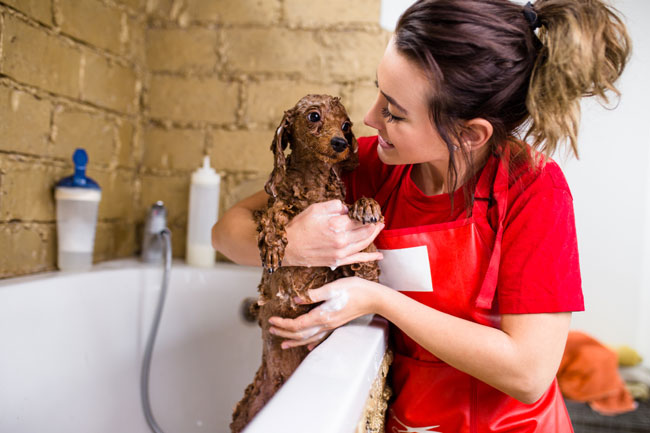Every dog requires some grooming, whether it’s as easy as nail trimming or as comprehensive as a poodle’s pompadour with bows. But not everyone has access to or can afford a monthly trip to the neighborhood dog “salon,” so we’ve put together some dog grooming guidelines from professionals around the country.
These professional dog grooming tips should make your daily life easier, make your pet appear to be a million bucks, and help to keep your budget intact.
Regular Professional Grooming for dogs is important for dogs of all breeds
1. Routine: Develop a routine that works for both you as well as your dog. Same shampoo, same bathing spot, same steps each time. This helps it be easier on you and they’ll know what to expect and become less anxious. Be sure to clean every part of this body, like the belly and face, and make sure that you rinse thoroughly. You don’t want any shampoo residue left on the skin or in the coat.
2. Pick the Shampoo: Exactly like for humans, there are several canine shampoos. Everything you choose depends on your needs:
To control fleas, you’ll use a flea shampoo.
For dry skin, try an oatmeal-based shampoo.
For skin irritations, dandruff, or hot spots, a medicated shampoo with coal tar and hydrocortisone should help.
Puppies need a special shampoo that won’t make them tear up. They are extra wiggly and there’s no avoiding getting suds in the eyes, so make it more comfortable with tearless puppy shampoo.
To brighten a coat, buy a whitening shampoo.
Sensitive skin will desire a hypoallergenic shampoo.
Generally, oatmeal-based shampoos are usually the best basic option. Additionally, conditioners can be utilized if your pet has dry or sensitive skin and dry or brittle hair. In addition, it can lessen matting.
3. Deshedding/Dematting: Have a comb or brush and sort out the coat as you’re rinsing to rid your pet of excess loose hair also to detangle any mats that they’ve developed. You’ll find it easier you do this through the bathing routine, rather than when you’re seeking to dry them.
4. Grooming Equipment: If you anticipate doing all the grooming yourself, one strongly suggested professional dog grooming tip is not to skimp on the various tools you’ll need (brushes, scissors, trimmers). Not merely will they last longer, but they will continue to work better than their cheaper cousins. Ensure that you clean your equipment after every use and lubricate and sharpen as necessary to prolong the life span of the tool.
5. Organize Your Equipment: Having everything in a single place – shampoo, combs, brushes, scissors, trimmers, etc. – could keep the procedure moving along. There’s nothing like an anxious dog making its escape when you seek out the right couple of scissors.
6. Get yourself a Helping Hand: Many dogs won’t sit still for drying and trimming, so you may desire a little help. One dog-grooming trick is by using a Groomers Helper device to stabilize your pet and keep him from struggling, biting, or spinning. It’ll make your task go by all those things considerably faster, relief for your dog as well. If equipment isn’t in your finances, ask a family member or friend your dog is more comfortable with to lend a helping hand.
7. Dry Before Grooming: Ensure that you thoroughly dry your pet before grooming. Partially dried coats will tend to curl more so that it is difficult to get a straight trim. This way you can certainly do one pass with the clippers, rather than two.
8. Grooming Made Easy: Always opt for the lay of the hair when trimming. Keep carefully the tip of your blade down against the skin, holding the trunk at an angle. Then pull your skin taut as you move your trimmer along the coat (to avoid cutting your skin).
